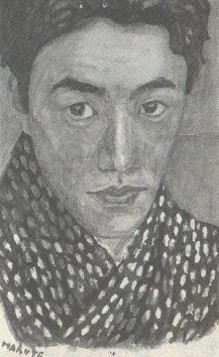去找一下
「お前はナニモノか」という問い ―古賀春江と川端康成と「末期の眼」(1)
古賀 春江(こが はるえ、1895年6月18日 - 1933年9月10日)は大正期に活躍した日本の初期のシュルレアリスムの代表的な洋画家(男性)である。本名は亀雄(よしお)。後に僧籍に入り「古賀良昌(りょうしょう)」と改名する。「春江」はあくまでも通称である。
他的生平有簡單的英文介紹
Harue Koga (古賀 春江 Koga Harue, June 18, 1895 - September 10, 1933) was a Japanese surrealist/avant-garde[1] painter active in the Taishō period.
[edit] His life
His real name is Yoshio. He entered the priesthood and was renamed "Ryosho Koga"; "Harue" is an alias. He was born as the eldest son of the priest of a buddhist temple, Zenfukuji. He belonged to the Pacific Ocean Painting Association Laboratory and the Japanese Watercolor Painting Laboratory after he had gone to Tokyo. He won Nika Prize for "Burial" in 1922. He established an art group "Action" in the same year. He devoted himself to Paul Klee between 1926 and 1927, and became good friends with Yasunari Kawabata.[1] A lot of his art works were influenced by the movements and painters in the West such as cubism (Fernand Léger), surrealism, Klee, etc., and his style changed one after another in a short term. In general, his work of several years following "Sea" is considered as the beginning of the surrealism painting in Japan, and had a big influence on the following Japanese arts.
 九 抒情詩圏の画家――古賀春江
九 抒情詩圏の画家――古賀春江「絵はがき(自画像)」1916年
沒有留言:
張貼留言